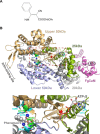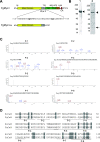Effects of Mutations in the Phenamacril-Binding Site of Fusarium Myosin-1 on Its Motor Function and Phenamacril Sensitivity
- PMID: 32905433
- PMCID: PMC7469408
- DOI: 10.1021/acsomega.0c02886
Effects of Mutations in the Phenamacril-Binding Site of Fusarium Myosin-1 on Its Motor Function and Phenamacril Sensitivity
Abstract
Phenamacril is a Fusarium-specific fungicide used for Fusarium head blight management. The target of phenamacril is FgMyo1, the sole class I myosin in Fusarium graminearum. The point mutation S217L in FgMyo1 is responsible for the high resistance of F. graminearum to phenamacril. Recent structural studies have shown that phenamacril binds to the 50 kDa cleft of the FgMyo1 motor domain, forming extensive interactions, including a hydrogen bond between the cyano group of phenamacril and the hydroxyl group of S217. Here, we produced FgMyo1IQ2, a truncated FgMyo1 composed of the motor domain and two IQ motifs complexed with the F. graminearum calmodulin in insect Sf9 cells. Phenamacril potently inhibited both the basal and the actin-activated ATPase activities of FgMyo1IQ2, with an IC50 in a micromolar range. S217 mutations of FgMyo1IQ2 substantially increased the IC50 of phenamacril. S217T or S217L each increased the IC50 of phenamacril for ∼60-fold, while S217A only increased the IC50 for ∼4-fold. These results indicate that the hydroxyl group of S217 plays an important, but nonessential role in phenamacril binding and that the bulky side chain at the position 217 sterically hinders phenamacril binding. On the other hand, S217P, which might alter the local conformation of the phenamacril-binding site, completely abolished the phenamacril inhibition. Because the cyano group of phenamacril does not form discernible interactions with FgMyo1 other than the nonessential hydrogen bond with the S217 hydroxyl group, we propose the cyano group of phenamacril as a key modification site for the development of novel fungicides.
Copyright © 2020 American Chemical Society.
Conflict of interest statement
The authors declare no competing financial interest.
Figures






Similar articles
-
Comprehensive analysis of the mechanisms conferring resistance to phenamacril in the Fusarium species.Front Cell Infect Microbiol. 2025 Feb 11;15:1536532. doi: 10.3389/fcimb.2025.1536532. eCollection 2025. Front Cell Infect Microbiol. 2025. PMID: 40007612 Free PMC article. Review.
-
Endocytosis in Fusarium graminearum requires coordination of the motor domain and two tail homology domains of myosin-1.Microb Pathog. 2025 Sep;206:107841. doi: 10.1016/j.micpath.2025.107841. Epub 2025 Jun 25. Microb Pathog. 2025. PMID: 40578707
-
Discovery of a species-specific novel antifungal compound against Fusarium graminearum through an integrated molecular modeling strategy.Pest Manag Sci. 2020 Dec;76(12):3990-3999. doi: 10.1002/ps.5948. Epub 2020 Jul 8. Pest Manag Sci. 2020. PMID: 32506565
-
The b-ZIP transcription factor FgTfmI is required for the fungicide phenamacril tolerance and pathogenecity in Fusarium graminearum.Pest Manag Sci. 2019 Dec;75(12):3312-3322. doi: 10.1002/ps.5454. Epub 2019 Jun 3. Pest Manag Sci. 2019. PMID: 31025482
-
Transcriptomics of cereal-Fusarium graminearum interactions: what we have learned so far.Mol Plant Pathol. 2018 Mar;19(3):764-778. doi: 10.1111/mpp.12561. Epub 2017 Jun 7. Mol Plant Pathol. 2018. PMID: 28411402 Free PMC article. Review.
Cited by
-
Comprehensive analysis of the mechanisms conferring resistance to phenamacril in the Fusarium species.Front Cell Infect Microbiol. 2025 Feb 11;15:1536532. doi: 10.3389/fcimb.2025.1536532. eCollection 2025. Front Cell Infect Microbiol. 2025. PMID: 40007612 Free PMC article. Review.
-
Comparative transcriptome analysis reveals the resistance regulation mechanism and fungicidal activity of the fungicide phenamacril in Fusarium oxysporum.Sci Rep. 2022 Jun 30;12(1):11081. doi: 10.1038/s41598-022-15188-5. Sci Rep. 2022. PMID: 35773469 Free PMC article.
References
-
- Dean R.; Van Kan J. A. L.; Pretorius Z. A.; Hammond-Kosack K. E.; Di Pietro A.; Spanu P. D.; Rudd J. J.; Dickman M.; Kahmann R.; Ellis J.; Foster G. D. The Top 10 fungal pathogens in molecular plant pathology. Mol. Plant Pathol. 2012, 13, 414–430. 10.1111/j.1364-3703.2011.00783.x. - DOI - PMC - PubMed
-
- Li H.; Diao Y.; Wang J.; Chen C.; Ni J.; Zhou M. JS399-19, a new fungicide against wheat scab. Crop Protection 2008, 27, 90–95. 10.1016/j.cropro.2007.04.010. - DOI
LinkOut - more resources
Full Text Sources

